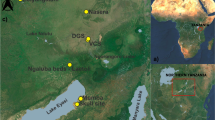Abstract
This paper presents a new map and account of the emergence and spread of spindle whorls in archaeological sites across southern China and southeast Asia. Spindle whorls are evidence of intensive yarn production, and hence of weaving. In the past two decades a considerable amount of new data on the presence of spindle whorls in the archaeological record has come to light, along with improved dates for existing sites. In mainland southeast Asia the occurrences of spindle whorls are linked to the emergence and spread of Neolithic lifeways, including rice farming. Remains of loom parts, a much rarer occurrence, are also considered. Loom components that have been misinterpreted or overlooked in previous publications are described and placed in context. Southwestern China emerges as a key center for innovation in weaving technique, linked with the emergence and differentiation of the ethnolinguistic groups found in the region today. Loom designs that belong to lineages that originated in the Neolithic period are still in use in rural areas southwestern China and southeast Asia today.








Similar content being viewed by others
Data availability
All of the data used in this article is available in the Supplementary Information.
Notes
References for the locations and dates on this map are in the Supplementary Material (S1). In most cases the dates assigned to each location are the mid-points of date ranges given in the original sources.
This object, formerly in the Irving Collection, was auctioned by Christies on 25th September 2020, described in the catalog as a jade ornament from the Liangzhu Culture. Its present location is unknown.
References
Anggraeni. 2022. Early metal age settlement at the site of Palemba, Kalumpang, Karama Valley, West Sulawesi. Asian Perspectives 61(1):92–111. https://doi.org/10.1353/asi.2022.0004.
Bacus, Elisabeth A. 2006. Social Identities in Bronze Age Northeast Thailand: Intersections of Gender, Status and Ranking at Non Nok Tha. In Uncovering Southeast Asia’s Past: Selected Papers from the 10th International Conference of the European Association of Southeast Asian Archaeologists, eds. Bacus, Elisabeth A., Ian Glover, and Vincent C. Pigott, 105–115. Singapore: NUS Press.
Bellwood, P. 1989. Archaeological investigations at Bukit Tengkorak and Segarong, southeastern Sabah. Bulletin of the Indo-Pacific Prehistory Association, 9: 122–162.
Bellwood, Peter, and Eusebio Dizon. 2013. Terra Australis 40: 4000 years of migration and cultural exchange: the archaeology of the Batanes Islands, Northern Philippines. Canberra: ANU Press.
Bellwood, Peter, Marc Oxenham, Bui Chi Hoang, Nguyen Kim Dzung, Anna Willis, Carmen Sarjeant, et al. 2011. An son and the neolithic of southern Vietnam. Asian Perspectives 50 (1/2): 144–175.
Blench, Roger. 2015. Reconstructing Austroasiatic prehistory. In Handbook of the Austroasiatic Languages, eds. Jenny M., and P. Sidwell. Leiden: Brill.
Boudot, Eric and Chris Buckley. 2015. Roots of Asian weaving. Oxford: Oxbow Books.
Buckley, Christopher. 2017. Looms, weaving and the Austronesian expansion. In Spirits and ships, eds. Andrea Acri, Roger Blench, and Alexandra Landmann, 273–324. Singapore: ISEAS Publishing.
Buckley, Christopher D., and Eric Boudot. 2017. The evolution of an ancient technology. Royal Society Open Science 4: 170208. https://doi.org/10.1098/rsos.170208.
Buckley, Christopher D. 2018. Connecting Tai, Kam and Li peoples through weaving techniques. Journal of the Siam Society 106: 95–130.
Buckley, Christopher. 2019. Tianluoshan ivory weft beater. In: A world of looms: weaving technology and textile arts, eds. Zhao Feng, Sandra Sardjono and Christopher Buckley, 192. Zhejiang: Zhejiang University Press.
Bulbeck, F. David. 2002. Recent insights on the chronology and ceramics of the Kalumpang site complex, South Sulawesi, Indonesia. Bulletin of the Indo-Pacific Prehistory Association 22 (2002): 83–100.
Cameron, Judith. 2006. New research into Dongson cloth from waterlogged sites in Vietnam. In Uncovering Southeast Asia’s Past-Selected Papers from the 10th International Conference of the European Association of Southeast Asian Archaeologists, eds Elisabeth A Bacus, Ian C Glover, Vincent C Pigott, 196–202. Singapore: NUS Press.
Cameron, Judith. 2011. Textile crafts in the gulf of Tongking: the intersection between archaeology and history. In The Tongking gulf through history, eds. Nola Cooke, Tana Li, and James A, Anderson, 25–38. Philadelphia: University of Pennsylvania Press.
Cameron, Judith. 2013. The spinning tools from Sunget, Anaro and Savidug. In 4000 years of migration and cultural exchange: the archaeology of the Batanes Islands, Northern Philippines, eds P. Bellwood and E. Dizon, 115–121. Canberra: ANU Press.
Cameron, Judith. 2015. Iron and cotton in the Indian Ocean littoral: new data from ThaKae, central Thailand. In Maritime Contacts of the past: deciphering connections amongst Communities, ed. Sila Tripati, 198–207. Delta World Book.
Cameron, Judith. 2019. Cloth production in ancient Tianluoshan. In A world of looms: weaving technology and textile arts, eds. Zhao Feng, Sandra Sardjono and Christopher Buckley, 23–27. Zhejiang: Zhejiang University Press.
Deng, Z., S.C. Kuo, M.T. Carson, and H.C. Hung. 2022. Early Austronesians cultivated rice and millet together: tracing Taiwan’s first neolithic crops. Frontiers in Plant Science 13: 962073. https://doi.org/10.3389/fpls.2022.962073.
Feng, Guangyu. 2006. Guangxi ethnic culture heritage collection. Beijing: China Social Sciences Press.
Gilligan, Ian. 2010. The prehistoric development of clothing: archaeological implications of a thermal model. Journal of Archaeological Method and Theory 17: 15–80.
Guoping, Sun, and Huang Weijin. 2007. Wenwu (Cultural Relics) 11: 4–24.
Hoang, Bui Chi. 2008. The Phu Chanh site: cultural evolution and interaction in the prehistory of southern Vietnam. Bulletin of the Indo-Pacific Prehistory Association 28: 67–72.
Hommel, Rudolf P. 1937. China at work. New York: John Day Company.
Howard, M.C., ed. 2006. Bark-cloth in Southeast Asia. Bangkok: White Lotus.
Hung, Hsiao-chun, and Chi Zhang. 2019. The origins, expansion and decline of early hunter-gatherers along the South China Coast. In Prehistoric Maritime cultures and Seafaring in East Asia, eds. C. Wu and B.V. Rolett, 53–79. Singapore: Springer.
Kuhn, Dieter. 1979. The spindle-wheel: a Chou Chinese invention. Early China 5: 14–24.
Kuhn, Dieter. 2012. Reading the magnificence of ancient and medieval chinese silks. In Chinese silks: 1–73, ed. Dieter Kuhn. Yale University Press.
Kuhn, Dieter, and Joseph Needham. 1988. Science and civilization in China: Vol. 5 Chemistry and Chemical Technology. Part IX: Textile technology: spinning and reeling. Cambridge: Cambridge University Press.
Long, Bo. 2019a. Liangzhu jade loom. In A world of looms: weaving technology and textile arts, eds. Zhao Feng, Sandra Sardjono and Christopher Buckley, 193–194. Zhejiang: Zhejiang University Press.
Long, Bo. 2019b. Laoguanshan pattern looms. In A world of looms: weaving technology and textile arts, eds. Zhao Feng, Sandra Sardjono and Christopher Buckley, 199–203. Zhejiang: Zhejiang University Press.
Long, Bo, and Feng Zhao. 2021. A high point in the development of ancient chinese pattern looms: the multiple heddle pattern device. Fiber Loom and Technique 2021: 1–12.
Mijares, Armand Salvador. 2017. Understanding the Callao cave depositional history. Terra Australis 45: 125–140.
Montell, Gosta. 1941. Spinning tools and spinning methods in Asia. In Sylwan, Vivi. Woollen textiles of the Lou-lan people. Stockholm: Statens Ethnografiska Museum.
Piper, Philip J., and Peter Bellwood. 2022. Lâm Thị Mỹ Dung, Nguyễn Khánh Trung Kiên, Nguyễn Thi Thuy, Charles FW Higham, Fiona Petchey, Elle Grono, and. The Neolithic of Vietnam. In The Oxford Handbook of Early Southeast Asia, eds. Highham C.F.W., and Nam C. Kim, 194–214. Oxford University Press, Oxford.
Roth, Henry Ling. 1918. Solomon Island Loom. In Studies in primitive looms, 108–112. Halifax: Bankfield Museum.
Sidwell, Paul, and Roger Blench. 2011. The Austroasiatic urheimat: the southeastern riverine hypothesis. In Dynamics of human diversity: the case of mainland Southeast Asia, ed. Enfield N.J., 315–343. Canberra: Pacific Linguistics.
Simanjuntak, Truman, Peter Bellwood and Philip Piper. 2014. Neolithic foundations in the Karama Valley, West Sulawesi, Indonesia. Antiquity 88 (341): 740–756.
Vollmer, John E. 1977. Archaeological and ethnological consideration of the foot-braced body-tension loom. In Studies in Textile History in memory of Harold B. Burnham, ed. V. Gervers, 343–354. Toronto: Royal Ontario Museum.
Vollmer, John E. 1979. Archaeological evidence for looms from Yunnan. In Irene Emery roundtable on museum textiles, 1977 proceedings: looms and their products, eds Irene Emery and Patricia Fiske, 78–89. Washington, DC: The Textile Museum.
Zhang Chi, and Hsiao-chun Hung. 2010. The emergence of agriculture in Southern China. Antiquity 84 (323): 11–25.
Zhang, Jianping., et al. 2016. Phytoliths reveal the earliest fine reedy textile in China at the Tianluoshan site. Scientific Reports 5: 18664. https://doi.org/10.1038/srep18664.
Zhao, Feng. 2005. A history of chinese silk art. Shanghai: Silk Art History Heritage Press.
Zhao, Feng. 2012. Studies of textiles and weaving technology, 7th – 3rd century BC. Shanghai: Shanghai Guji Chubanshi.
Zhao, Feng, Yi Wang, Qun Luo, Bo Long, Baichun Zhang, Yingchong Xia, Tao Xie, Shunqing Wu, and Lin Xiao. 2017. The earliest evidence of pattern looms: Han dynasty tomb models from Chengdu, China. Antiquity 91 (356): 360–374.
Acknowledgements
The author thanks the China National Silk Museum for the opportunity to examine remains of looms from sites in China, during the World of Looms conference in 2018, and two anonymous reviewers for their comments on a draft version of this article.
Author information
Authors and Affiliations
Corresponding author
Ethics declarations
The author did not receive support from any organization for the submitted work.
The author has no relevant financial or non-financial interests to declare.
Conflict of interest
The author states that there is no conflict of interest.
Additional information
Publisher’s Note
Springer Nature remains neutral with regard to jurisdictional claims in published maps and institutional affiliations.
Supplementary Information
Below is the link to the electronic supplementary material.
ESM 1
(XLSX 19.7 KB)
Rights and permissions
Springer Nature or its licensor (e.g. a society or other partner) holds exclusive rights to this article under a publishing agreement with the author(s) or other rightsholder(s); author self-archiving of the accepted manuscript version of this article is solely governed by the terms of such publishing agreement and applicable law.
About this article
Cite this article
Buckley, C.D. The origins of southeast Asian weaving traditions: the perspective from archaeology. asian archaeol 7, 151–162 (2023). https://doi.org/10.1007/s41826-023-00074-4
Received:
Accepted:
Published:
Issue Date:
DOI: https://doi.org/10.1007/s41826-023-00074-4




